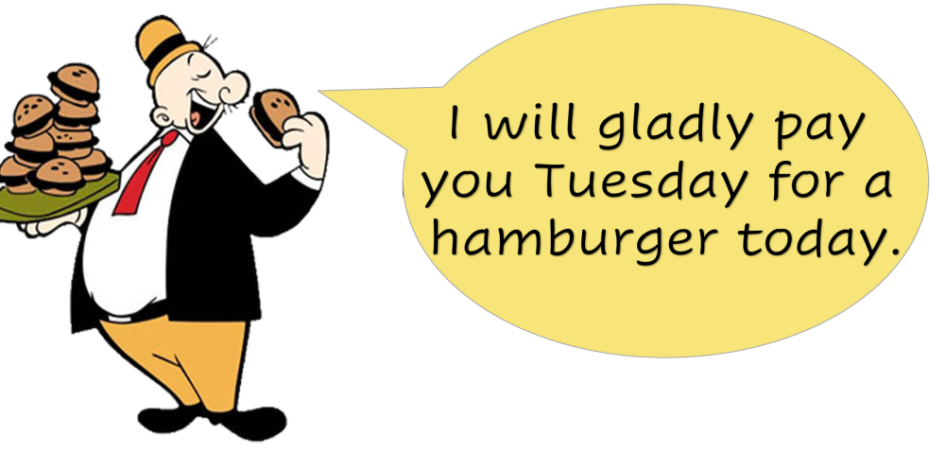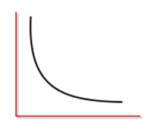[Full disclosure – this is a post form 2008 but evergreen]
To paraphrase Wimpy from the Popeye cartoon, “I’ll gladly reward you Tuesday for your behavior today.”
Every incentive and reward program is really a trade-off between behavior and a reward of some kind. We ask our audience to do something and in turn, we reward them for their effort. The idea is that the award will be of sufficient value and/or desire to affect their behavior. Like Wimpy, we typically ask our audience for something now with the promise that we’ll deliver something in the future.
But there are some interesting psychological implications in this give/reward relationship.
Temporal Discounting
There is a well-known behavioral principle called temporal discounting. People tend to prefer smaller rewards received sooner than larger rewards offered later. And the discounting is very steep. The further out in time the award date is the greater that award value must be in order to balance out in the participant’s mind.
If I say I’ll pay you 20 burgers (staying with Wimpy on this) next week or 21 burgers in four weeks, most people will choose the 20 burgers – they discount the extra burger by the three-week time lag. In other words, one more burger isn’t worth the wait. However, if I increase the value of the delayed award to say 40 burgers – I can match the performance of the more immediate reward. However, due to temporal discounting the award has to be much greater.
This can be a very important concept when designing a reward program and the impact on your budget can be significant.
Sooner is Cheaper
If you are considering a program where either the program rules or the system used to track behavior creates a long delay between the behavior and the reward– you may have to offer a much larger reward than if you could provide the reward sooner. This is especially true if the behavior is one that can be accomplished quickly or easily.
In other words – you could reward someone for their behavior with an award valued at 20 burgers within a week – but if the process requires that you reward them in 4 weeks – you may have to up the ante and reward them with 40 burgers to get the same performance.
People will do the mental math –mostly subconsciously, and determine the effort today isn’t worth the 40 burgers in four weeks – and may ignore your incentive.
I’m sure there are some mathematically focused HR and Sales folks that are going to ask – what is the equation that will tell me the discount rate for my behavior/award function? I can’t tell you that.
What I can tell you is that the sooner you can hit the person with their award – the cheaper the program will be.
In addition, here are a couple of interesting facts (theories?) about temporal discounting that have come up in the research…
- Men seem to discount faster – they seem to be less patient and need a greater difference between the short- and long-term award value. This can play a part in your program if you have a large portion of either male or female participants.
- Using dates vs. time frames decreases discounting. In other words, saying that the award will be delivered on September 2nd is versus saying it will be delivered in four weeks decreased the amount of the discount. Using dates may allow you to use a smaller award in the future when the reward lag is positioned as a date in time versus a time frame.
One More Thing…
Temporal discounting follows a “hyperbolic” curve. Don’t ask me to get into the math (I trust Wikipedia on this one) but what it means is the curve to the left.
If I take my original example (20 in one week, 21 in four weeks) and push out the entire timeline and now offer 20 hamburgers in 10 weeks and 21 hamburgers in 13 weeks, most people now choose the 21 hamburgers. In both examples, the delay between the small and large awards is exactly the same – 3 weeks. Why would the extra hamburgers now seem worth the three-week wait when it wasn’t worth it in the first offer? People will discount the award less when both options are far enough in the future.
Our discounting brain assumes if I must wait anyway, I might as well take the larger award.
Where this can have an impact is in those situations where the audience understands the time lag. Recognition programs play into this very well. Knowing that the program is a 12-month program and rewards longer-term objectives – the value of the award may not need to be incrementally larger to get support and attention just because it is in the future.
Now… about those hamburgers…
My advice is valuable sooner and later. But sooner is better. Just click this link and we can talk through how to design the best incentive program using techniques such as this.






Recent Comments